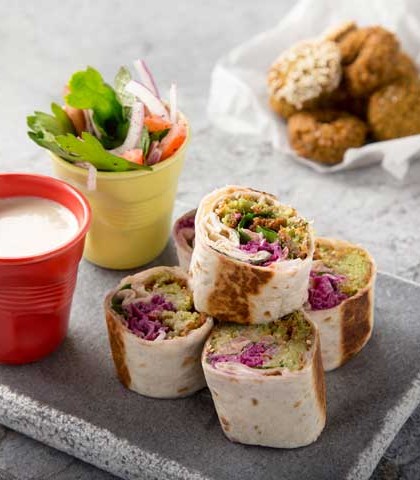Salads are dishes consisting of raw or cooked vegetables, meat or seafood, which may be mixed with a sauce or topped with a dressing. They can be served as appetizers, main courses, side salad or dessert salad.
The word “Salad” originates from the French “Salade”; sharing the same meaning with the Latin word “Salata” meaning salty or from “sal” meaning salt.
Salads are hot or cold, classical or contemporary, cooked or uncooked, simple (with one ingredient) or compound (with many ingredients) and may also include leftovers from a previous meal or carbohydrate ingredients like pasta, fresh or dried herbs like oregano, poached or boiled eggs or even lentils.
Salads originated in Europe, predominantly from France, Rome and Greece in the early 1700’s. The cuisines of these places have always been very balanced and the intake of salads has helped them live a healthy lifestyle.
In the early 19th century, America picked up on the trend of salads and made it their own by developing the “Salad Bar” concept, wherein every restaurant would have an unlimited salad buffet as a starter for any meal menu. Countries such as Japan, Australia and China followed suit.
Making a salad is an art and has 4 components, each of the components plays a vital role in the final dish and these are:
Base
A base would generally comprise of leaves; giving a definition to the salad on a plate or platter.
Some popular leaves that could be used as a base of the salad: Spinach, Ice Berg Lettuce, Romaine Lettuce, Swiss Chard and Endive.
Body
The body is the main ingredient in the salad and forms the focal point of the presentation and sits on top of the base. Some popular ingredients that could be used as a body for a salad are:
Vegetables: Tomato, Cucumber, Corn, Capsicum, Celery, Avocado
Proteins: Boneless chicken, Beef strips, Boiled/Poached egg, Prawns, Salmon and other Poached Seafood
Beans: Soya beans, Mung beans(dried and sprouted), Chick peas, Cannellini beans, Red kidney beans
Dressing
Dressing is used to enhance flavor and are poured over the body of the salad. Some of the ingredients used in popular dressings are:
Vinaigrettes: Balsamic Vinaigrette, Citrus Vinaigrette, Apple Cider Vinaigrette
Flavored Oils: Chili, Garlic, Herb Flavoured Oils
Mayonnaise: Mayonnaise, Cocktail sauce, Tartar sauce
Yogurt: Tzatziki
Garnish
Garnishes add texture, color and give form to the salad. These could be of any kind, either raw or cooked.
Example, if the ingredients are raw then leaves of herbs like basil and parsley are used to garnish. In case of a salad with cooked ingredients, a Cherry Tomato, which has been grilled can be used.
Salads are actually creative dishes, that can be served at any point of the meal and here are some different kinds of salads:
Appetizer Salad: a light salad to stimulate the appetite before the first course of the meal.
Side Salad: which accompanies the main course as a side dish.
Palate Cleansing Salad: which helps settle the stomach after one course or to refresh the palate between courses.
Dessert Salad: these are sweet and usually contain fruits, gelatin or whipped cream and are served as desserts.
Salads are classified as simple salad when one or more primary ingredients make up the body. All the ingredients here are raw and fresh and with a single dressing.
A salad is classified as a compound salad if the body is made up of raw & cooked ingredients together and if there is a creative balancing of flavors, colors, textures & taste. A compound salad could be meat, fish, fruit or vegetable based.
A salad is classified as a green salad if it only includes raw ingredients; it doesn’t necessarily have to be plain simple greens, it could also be vegetables such as red bell peppers, pumpkins, beetroots & turnips.





